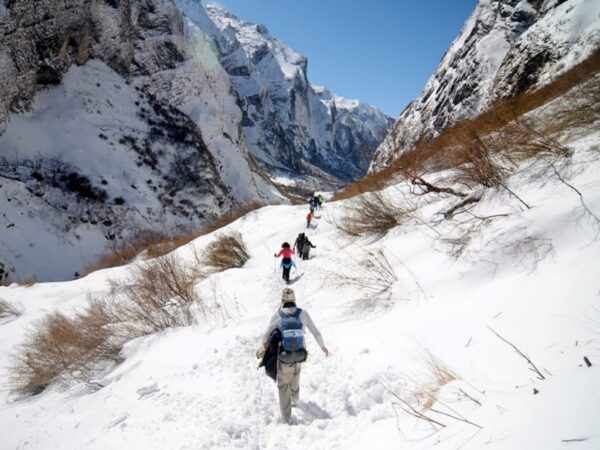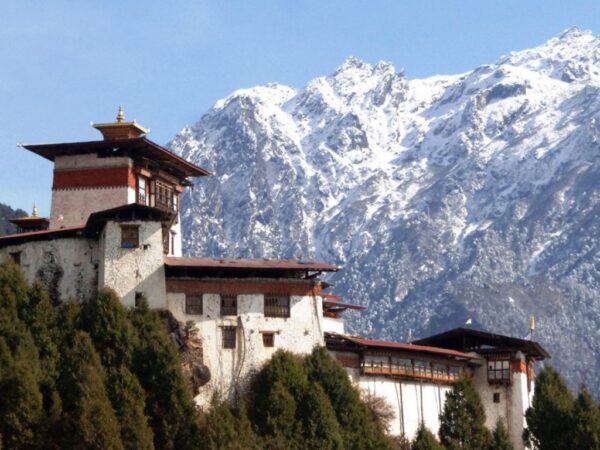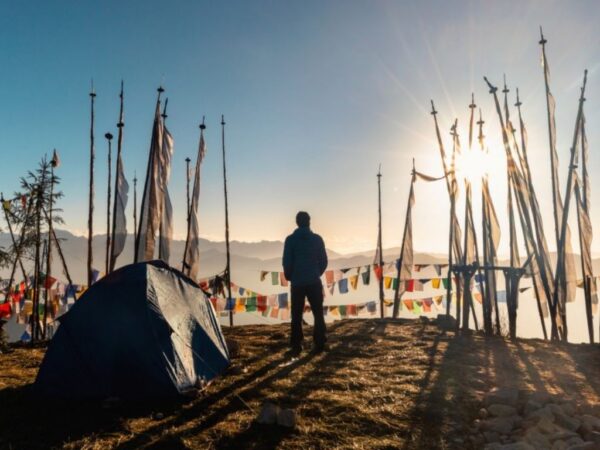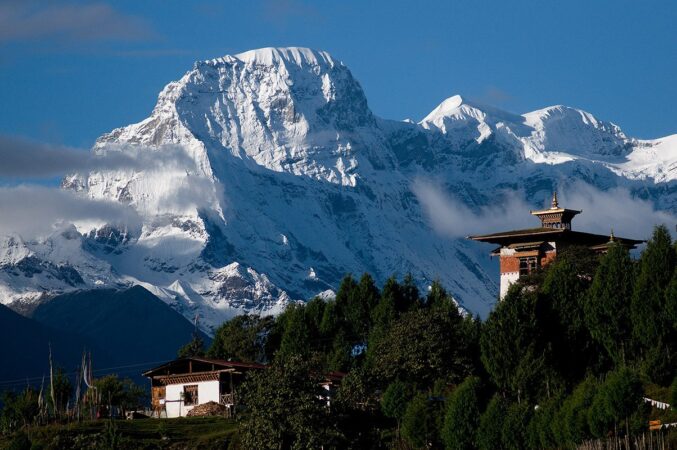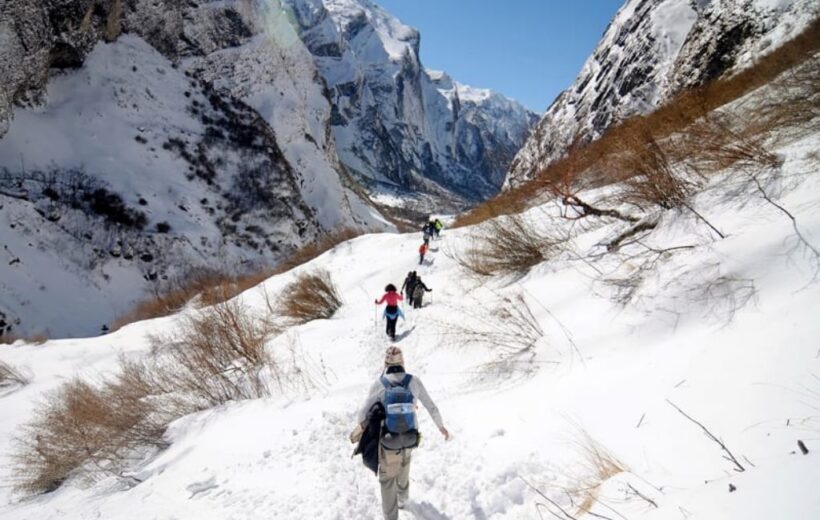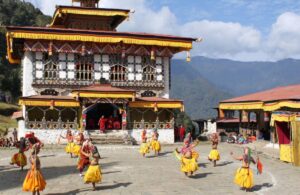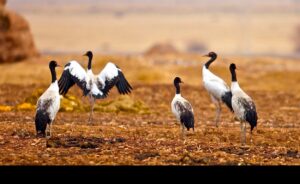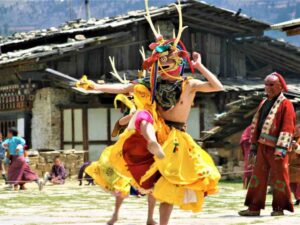Overview
The Snowman Trek II is an adventurous 25-day journey through the remote and rugged landscapes of Bhutan. Beginning at Gunitsawa Village and concluding at Duer Village, this trek traverses high-altitude passes, pristine valleys, and traditional villages. Highlights include the scenic Jangothang, Lingshi, and Laya regions, with rest days for acclimatization and exploration. Trekkers will experience stunning views of Bhutan's highest peaks, including Mount Gangkhar Puensum, and visit its base camp. The route also passes through Rhoduphu, Tarina, Thanza, and Tshorim, offering a mix of cultural encounters and natural beauty. The trek culminates in the relaxing hot springs of Duer Tsachu before ending at Duer Village, marking the completion of this challenging and rewarding adventure.
Included/Excluded
- The Bhutan SDF
- All accommodations
- Meals and mineral water
- A licensed English-speaking guide
- A driver and vehicle
- Air fare
- A visa fee of US$40
- Alcohol
- Gifts/Souvenirs
- Travel insurance and personal bills
- Museums & Monument Fees
Tour Plan
Day 1: Gunitsawa Village – Sharna Zampa
This trek begins at Gunitsawa Village were you pass the army post. At the army checkpost your trek permit (provided by your tour operator) will be checked and endorsed. The campsite is on the opposite side of the river, not far from Gunitsawa.
Day 2: Sharna Zampa - Thangthangkha
On this long day, the trail continues with lots of small ups and downs. After going uphill through the river valley the valley finally narrows gradually to a mere path which descends to a meadow where a camp will based.
Day 3: Thangthangkha – Jangothang
If you did not see Mt. Jomolhari the previous evening, you will still have a chance to get a great view early this morning. This morning the trek continues up the Paro Chhu valley which widens into patches of alpine meadow.
Day 4: Jangothang Halt
The rest day in Jangothang provides plenty of possibilities for day hikes with great views of lakes and snow capped mountains such as Jomolhari and Jichu Drake. There are good chances to spot some blue sheep on the upper slopes of the valley.
Day 5: Jangothang – Lingshi
This is one of the longest days of the trek. A short distance from the camp the trail begins climbing rapidly for about half an hour and then becomes a gradual ascent to the Nyilila pass at 4,870m.
Day 6: Lingshi – Chebisa
Today is the shortest walking day, and you can really take it easy. Shortly after starting you will reach a chorten below Lingshi Dzong. Here, you have the choice of staying on the main trail or taking a detour upward.
Day 7: Chebisa – Shomuthang
The morning starts with a long ascent behind Chebisa Village (2-3 hours) through a wide pastureland towards Gobu La (pass). On the way, you will see a few people herding yaks.
Day 8: Shomuthang – Robluthang
You begin by climbing up the valley to view Kang Bum (6,526 m) and some edelweiss. After two hours of climbing you will reach Jhari La (4,750m), from where you catch the first glimpse of Sinche La.
Day 9: Robluthang – Limithang
The trek starts out with an initial 40-60mins ascent before gradually raising for another 1.5 hours through a boulder field. It is then a 1 hour steep ascent before reaching Sinche La (5,005m).
Day 10: Rest in Laya
If you have trekked from Paro Valley you should spend a day recuperating from the trek to Laya and preparing yourself for the rest of this challenging but spectacular trek. If you have started from Gasa (Punakha) you should also walk up to Laya.
Day 11: Laya – Rhoduphu
From Laya we descend to an army camp and continue following the river till the turn off point to Rhoduphu. After lunch the climb continues through rhododendron bushes till you reach the camp at Roduphu.
Day 12: Rhodophu – Narethang
After following the river for about half an hour you will have a steady climb to a high open valley at 4,600m and then further up to Tsomo La (4,900m). Tsomo La offers a superb view of Lunana, Mount Jomolhari and JichuDrake.
Day 13: Narethang – Tarina
From the camp you will climb for about an hour to Gangla Karchung La (5,120m). The view from the pass is breathtaking and the whole range of mountains including Jekangphu Gang (7,100m), TsendaGang.
Day 14: Tarina – Woche
The walk leads down through conifer forests following the upper ridges of the Pho Chhu, passing some impressive waterfalls. The trail then climbs over a ridge and drops to Woche.
Day 15: Woche - Lhedi
The trek starts through juniper and fir forests, and further ahead, through rhododendron bushes. Climb up to Keche La pass (4,650m) where one can have the great view of surrounding mountains again.
Day 16: Lhedi - Thanza
In clear weather, you will have great views of Table Mountain (7,100m). Around lunchtime you will pass the small village of Chozo (4,090m) which has a dzong still in use. Reaching Thanza again you will have a great scenary view.
Day 17: Rest day at Thanza
In Thanza walk around and experience some village life or climb up the ridge for fascinating views of lakes and mountains. But as it takes time to arrange new yaks (the yaks from Laya will not go further than Thanza) you might have to spend one day at Thanza anyway.
Day 18: Thanza - Tshorim
Having chosen the route to Bumthang the trek starts by climbing a ridge with a great view of Table Mountain and Thanza valley below. The ridge altitude is 4,500m and it rises gradually up to 4,650m.
Day 19: Tshorim – Gangkhar Puensum Base Camp
This is one of the highlights of the trek and the day starts with a short climb to the Tshorim Thso. You walk on the side of the lake enjoying a panoramic view of the Gophu La ranges. The last climb to the Gophu La pass (5,230m) is very short.
Day 20: Gangkar Puensum Base Camp – Geshe Woma
The trail further follows the Sha Chhu and descends gradually to Geshe Woma.
Day 21: Geshe Woma – Warathang
The path continues following Sha Chhu for two and a half hours until the stiff climb to Saka La begins. Visibility along the Saka La trail is poor so one must see top of the ridge for guidance.
Day 22: Warathang - Duer Tsachu
A one hour climb leads to Juli La (4,700m). After the pass, you descend to the riverside through dense rhododendron, juniper and conifer forests. After the bridge a short climb leads to Duer Tsachu.
Day 23: Duer Tsachu - Tshochenchen
From the hot springs it is a long and steady climb again with great views of mountains in Lunana. You will also come across blue lakes and yak herder huts.
Day 24: Tshochenchen – Duer Village
This is the last day of the trek and your porters change from yaks to horses. The path follows the Chamkhar Chhu, descending gradually with a few climbs in between. The trek ends here when you arrive at Duer village. From here you drive to Jakar (Bumthang).
Snowman Trek II - Finish
Tour Map
You may like
Frequently asked question
Itinerary is always flexible if you are travelling in a smaller group. You have a choice of eating in a different restaurant, however, the menu depends on the chef and usually it is a set menu but not necessarily the same menu every day.
It is in the tourism industry but it is not compulsory. It actually depends on the service rendered to you.
Yes, things that are not included in the tariff are all beverages, telecommunications, tips, laundry, massage and souvenir shopping.
Bhutan is well connected and every town has IDD services. Internet cafes are available almost everywhere. Cell phones can also be used but you need to get Bhutan prepaid SIM Card and recharge it. Recharge vouchers are available at every second shop in town.
You can exchange money in the banks as well as in the hotels were you are staying. Rates will be better in the banks plus US$ is acceptable in almost all of the shops in town.
It cannot be safer anywhere else in the world.
Bhutan is all season tourist destination for cultural tours. However the month of February, March, April, and September, October, November are considered the best time due to pleasant weather conditions. December and January are winter months and June, July and August, the rainy season. It is important to note that the climatic conditions during the winter months are not extreme. The average temperature would range from 10-17 degree Celsius during day time.
The money you have transferred will be with held by the Tourism Council of Bhutan till the day you depart. Travel Agents can only withdraw the money after your departure upon submitting your tour invoice. Therefore, your money is safe.
It is government rule that total tour payment must be remitted without which the government will not issue the visa.
Decide the number of days you want to spend in Bhutan according to your interest and budget.
Decide the date and the port of entry (You can fly into Bhutan from one of these cities; Bangkok, Katmandu, New Delhi, Calcutta and Dacca) into Bhutan.
Fill up the visa application form (You can download the visa application form here).
Remit the total tour payment (You can download the money transfer details here). It is government rule that total tour payment must be remitted without which the government will not issue the visa.
Once we have confirmed dates, port of entry, dully filled visa application form, and money received, we will process your visa.
Except for travelers from India, Bangladesh and Maldives, all visitors to Bhutan are required to obtain visa approval prior to their arrival, which will be processed by us.
Tourism is not restricted but the minimum daily tariff is set by the government. It is also necessary that all tourists must come through a registered tour operator to plan your itinerary and process your visa. Tourist cannot come on their own unless they are invited guest.
Druk Air operates daily flight (once daily) from Bangkok (Thailand) and four flights a week from New Delhi, Kathmandu and Calcutta (India) and two flights a week from Dacca (Bangladesh). There are different flight schedules for the summer and the winter seasons. For Druk Air schedules click on Flights Details or you can also visit Druk Air web site at www.drukair.com.bt . You can also enter Bhutan via Bagdogra Airport, Siliguri (West Bengal) in India. It has regular flights from New Delhi (twice daily).
Bhutan is connected to the outside world through Druk Air (Royal Bhutan Airlines), the national carrier which is the only airline operating flights in and out of the kingdom.

